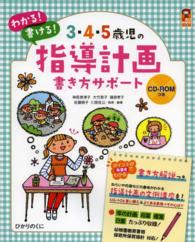Full Description
This is a pocket-sized, spiral-bound, full-color reference to the information new RNs and nursing students are most likely to need while providing clinical care. Reflecting extensive new input from nurse educators and nursing students, CLINICAL POCKET GUIDE FOR THE RN thoroughly integrates the latest QSEN and National Patient Safety Goals, helping students and nurses deliver safer patient care. Easy-reference tabs give readers fast access to reliable information about emergency care, medication, complete assessment (adult, pediatric, geriatric, and maternal-newborn), culture, psychosocial issues, and procedures. Emphasizing patient-centered care throughout, this text covers everything from accurate dosage calculation to the safe use of complementary or alternative care.
Contents
I. AssessmentVital Signs Across the LifespanCapillary Refill TimePulse AssessmentPulse PointsEdema ScaleFactors Affecting Vital SignsHead to Toe Assessment GuideAssessment ToolsGordon's Functional Health PatternsOrem's Universal Self-Care RequisitesPain Assessment and ManagementPost-Op AssessmentAssessing HydrationHypoglycemia Versus Hyperglycemia ManifestationsOrientation AssessmentFall AssessmentRespiratory Patterns, Breathe Sound DescriptionsReflex AssessmentManifestations of Altered Electrolyte Levels - Most Commonly SeenPredicting Due Date (Nagele's Rule)Manifestations of Labor StagesTrue Vs. False LaborNewborn Assessment (Apgar Scoring)Normal Changes with AgingCancer Warning SignsCancer Scoring/GradingAbuse Signs and SymptomsRule of 9 and Burn Assessment/CharacteristicsTypes of Shock with Manifestations and Interventions for EachII. Procedures TabTypes of Isolation with Standard Precautions, PPE to UseCommon Dressings for Different Wound TypesDocumentation Considerations (With Table of Directional Terms)Checking n/g PlacementHousehold to Metric EquivalentsDelegation ChecklistCritical Thinking ChecklistCalling a Doctor ChecklistIII. EmergencySeizure ResponseLead Placement for ECGRecognizing Common ArrhythmiasSteps to Take to Analyze an ECG RhythmOxygen Delivery Methods With Percentages DeliveredVentilator Alarm TroubleshootingChest Tube TroubleshootingEnteral Feeding Tube TroubleshootingABG Normals, Causes and Symptoms of AlterationsSteps for Analyzing ABGRecognizing Exposure to BioterrorismVentilator Alarm TroubleshootingIV. LabsInterpreting Lab ResultsTube Colors for Common LabsGeneral Normal Values for LabsTypes of Urine CollectionNormal Results of Tests Performed by NursesAdministering Blood Safety ChecksTransfusion Reaction Manifestations With Actions to Takethe Order to Collect Different Colored TubesGastroccult and Hemoccult TestingV. PsychosocialErikson's StagesSafety Considerations for Each StageMaslow's HierarchyPediatric Milestones in DevelopmentS&S Anxiety, Depression, Suicide AssessmentCultural Beliefs and Values by Ethnic and Religious GroupsVI. MedicationFormula for Calculating Dosages7-10 Rights5 ChecksMaintaining Safety When Preparing MedsDo Not Use AbbreviationsImmunization ScheduleInjection Sites (Peds and Adult) for IM, Subq, and Intradermal with Maximum Fluid to Be InjectedMedication Considerations for Different Age Groups/ProblemsMedications to Use Cautiously With Geriatric ClientsSteps to Take When Med Error OccursIV Drip Rate Cal and TableFluid Requirements for Pediatric PatientsIV Solutions, Volume Expanders, and Blood Products With Indications for EachTypes of Insulin With Onset, Peak, and DurationSteps for Mixing InsulinsTroubleshooting/Assessing IV ProblemsCommonly Prescribed Drugs (Generic Name, Brand Name, and Classification)BSA calculationNeedle/Syringe SizesVII. Cultural ConsiderationsCultural Beliefs and Values by Ethnic and Religious GroupsAfrican AmericanAfricanHispanicAsianArabicAmerican IndianCatholicJewishMuslim VIII. End MatterPoisoning CentersSymbols and AbbreviationsMedical Terminology DefinitionsList of Helpful Web Sites







